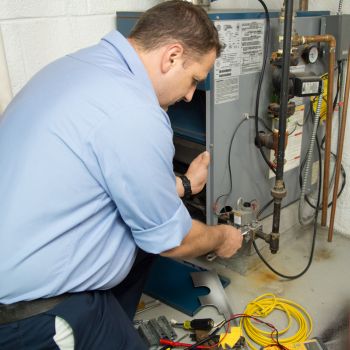Operational Costs for Gas vs. Electric Furnaces
 Whether your furnace recently died, you’re remodeling or flipping a home, you’ll likely have to choose gas or electric to replace it. While energy-efficient appliances are preferred, fuel availability and seasonal conditions in your region may affect what you’re able to install.
Whether your furnace recently died, you’re remodeling or flipping a home, you’ll likely have to choose gas or electric to replace it. While energy-efficient appliances are preferred, fuel availability and seasonal conditions in your region may affect what you’re able to install.
Currently, natural gas remains the most popular fuel type in the United States but not all regions have a sufficient network for connecting appliances. Gas furnaces also tend to be more complicated to set up, install and don’t last as long as an electric model.
While more affordable upfront, electric furnaces can be ideal for more moderate climates, as they take longer to heat a home. As you consider the pros and cons of each, understand the differences between these two common options.
Furnace Operation
In general, both gas and electric furnaces are forced-air systems. Air gets heated in the furnace before it travels through a series of ducts to warm the home. Considering this, both systems are equipped with pressure and airflow gauges, as well as safety valves in the event the unit starts to malfunction.
Beyond these commonalities, gas furnaces require more steps to heat air and are considered a combustion appliance. A gas line and valve provide a fuel source, an igniter creates a flame that helps heat the air, and the heat exchanger ensures the heat is safe for use and free of gas byproducts.
More efficient gas furnaces may include two heat exchangers. As this occurs, the byproducts or exhaust are diverted out of your home through a chimney flue or a pipe. Despite the extra steps, gas furnaces tend to heat homes faster than electric ones and usually perform better in colder climates.
For an electric furnace, an air handler with heating coils warms the air that flows into the appliance before it’s pushed through a series of ducts traveling through your home. The furnace may function alone or be supplemented by an electric heat pump, which helps reduce energy consumption for a more efficient system.
Along with these points, electric furnaces offer quieter operation as they heat up your home. Yet compared to gas furnaces, they can take longer to warm up a comparably sized dwelling and have a harder time maintaining higher temperatures. This combination makes them a better solution for providing heat in regions with more moderate climates.
Costs and Lifespan
Gas furnaces cost more to install upfront for their sophisticated design and last an average of 15 years with proper maintenance. Yet once they are set up, gas furnaces consume less energy than an electric model and you end up spending less to heat your home.
On the other hand, electric furnaces can last 20 to 30 years and are more straightforward to install. However, due to the amount of power needed to heat a home, you may see a higher electric bill during the winter. Especially in colder regions, electric furnaces can experience wear sooner and may need more repairs.
However, your electric furnace uses less energy with a heat pump in the picture, making it more cost effective and energy efficient compared to an electric furnace alone or a gas furnace.
Furnace Usage
Gas furnaces consume less energy due to the availability of natural gas as a fuel source. Where availability and costs are concerned, using gas for part of the year before switching to air conditioning provides more comfortable, cost-effective heating, especially in a colder climate.
The costs of electric, with or without a heat pump, tends to benefit homeowners if they live in a mild to moderate climate with only a couple months of cold temperatures per year. Along with heat pumps to keep costs down, electric furnaces are more easily combined with another fuel source, like oil or propane for more cost-effective heating in cooler climates.
Furnace Maintenance
Yearly maintenance is recommended for all furnaces, no matter the fuel source. With a gas furnace, maintenance involves assessing the operation of the igniter, flame sensor, burners and pilot lights to ensure the system continues to efficiently heat your home without consuming an excessive amount of fuel. The heat exchanger will also be inspected to make sure carbon monoxide is not leaking into the home.
With an electric furnace, consider scheduling seasonal appointments to clean components, assess the condenser coil and make sure refrigerant from the heat pump is not leaking.
Risks and Efficiency
For homeowners, carbon monoxide leaks remain a concern with gas furnaces. Because this gas is being emitted and diverted away, the system must always be maintained to prevent leaks, which commonly stem from a cracked heat exchanger.
In this regard, electric units are safer and assumed to provide more energy-efficient heat. Yet if you’re thinking about your carbon footprint, you’re advised to consider the big picture. Although your home might not be using natural gas, coal continues to produce much of the power needed to operate electric appliances.
Whether for installation or repairs, work with our HVAC professionals service your home’s gas or electric furnace. Contact us to make an appointment today.




